Research on Risk Contagion in ESG Industries: An Information Entropy-Based Network Approach
Abstract
1. Introduction
2. Materials and Methods
2.1. Network Model
2.2. Transformation of Adjacency Matrices into Stochastic Matrices
2.3. Network Entropy
2.4. Network Measurement Indicator
- Total in degree. The total in degree represents the extent to which a node is susceptible to the influence of other nodes [55]. A higher total in-degree means that more nodes have a direct impact on it, indicating that this node is more influenced within the network. For a node j, its total in-degree at time t is defined as follows:
- Total out degree. The total out degree represents the extent of its influence on other nodes [55]. A higher total out-degree means that the node has a direct impact on a larger number of other nodes within the network, indicating that it has greater influence or contagion capability in the network. For a node j, its total out-degree at time t is defined as follows:
- Relative influence. We calculate the relative influence (RI) as the ratio between the difference and the sum of out-tail interconnectedness and in-tail interconnectedness [34]. This indicator enables capturing the sector’s relative impact and magnitude of risk spillover onto other sectors. A positive value signifies that the sector generates more systemic risk than it receives, while a negative value indicates that the sector receives more systemic risk than it generates:
- Centrality of contagion. The degree to which a node is central in the network indicates the distance of the node from other parts of the network in terms of contagion distance. More central nodes have higher centrality values and are good propagators of shocks. Referring to Abduraimova [56], the centrality of contagion for node j at a given time t is defined as follows:
2.5. Mantel Test
3. Results
3.1. Data
3.2. Statistical Analysis of VaR and CoVaR
3.3. TENET Network Model Visualization Analysis
3.4. Network Entropy
3.5. Time-Varying Network Structure Analysis
3.6. Correlation Analysis of ESG Industry and Traditional Industry Based on the Mantel Test
4. Conclusions
Author Contributions
Funding
Institutional Review Board Statement
Informed Consent Statement
Data Availability Statement
Acknowledgments
Conflicts of Interest
References
- Guo, Y.; Li, P.; Li, A. Tail risk contagion between international financial markets during COVID-19 pandemic. Int. Rev. Financ. Anal. 2021, 73, 101649. [Google Scholar] [CrossRef]
- Zhang, W.; Zhuang, X.; Wang, J.; Lu, Y. Connectedness and systemic risk spillovers analysis of Chinese sectors based on tail risk network. N. Am. J. Econ. Financ. 2020, 54, 101248. [Google Scholar] [CrossRef]
- Zhang, D.; Hu, M.; Ji, Q. Financial markets under the global pandemic of COVID-19. Financ. Res. Lett. 2020, 36, 101528. [Google Scholar] [CrossRef] [PubMed]
- Abuzayed, B.; Bouri, E.; Al-Fayoumi, N.; Jalkh, N. Systemic risk spillover across global and country stock markets during the COVID-19 pandemic. Econ. Anal. Policy 2021, 71, 180–197. [Google Scholar] [CrossRef]
- Becchetti, L.; Ciciretti, R.; Dalò, A. Fishing the corporate social responsibility risk factors. J. Financ. Stab. 2018, 37, 25–48. [Google Scholar] [CrossRef]
- Cerqueti, R.; Ciciretti, R.; Dalò, A.; Nicolosi, M. ESG investing: A chance to reduce systemic risk. J. Financ. Stab. 2021, 54, 100887. [Google Scholar] [CrossRef]
- Gao, Y.; Li, Y.; Zhao, C.; Wang, Y. Risk spillover analysis across worldwide ESG stock markets: New evidence from the frequency-domain. N. Am. J. Econ. Financ. 2022, 59, 101619. [Google Scholar] [CrossRef]
- Shaik, M.; Rehman, M.Z. The Dynamic volatility connectedness of major environmental, social, and governance (ESG) stock indices: Evidence based on DCC-GARCH model. Asia-Pac. Financ. Mark. 2023, 30, 231–246. [Google Scholar] [CrossRef]
- Xia, X.; Xiang, P. Dynamic network analysis of stakeholder-associated social risks of megaprojects: A case study in China. Eng. Constr. Archit. Manag. 2023, 30, 4541–4568. [Google Scholar] [CrossRef]
- Arranz, C.F.A.; Sena, V.; Kwong, C. Dynamic capabilities and institutional complexity: Exploring the impact of innovation and financial support policies on the circular economy. IEEE. Trans. Eng. Manag. 2023; 1–15, early access. [Google Scholar] [CrossRef]
- Xue, X.; Luo, J.; Wang, Z.; Ding, H. Impact of Green Credit Policy on the sustainable growth of pollution-intensive industries: Evidence from China. Comput. Ind. Eng. 2023, 109371. [Google Scholar] [CrossRef]
- Battiston, S.; Farmer, J.D.; Flache, A.; Garlaschelli, D.; Haldane, A.G.; Heesterbeek, H.; Hommes, C.; Jaeger, C.; May, R.; Scheffer, M. Complexity theory and financial regulation. Science 2016, 351, 818–819. [Google Scholar] [CrossRef]
- Peng, S.; Yang, S.; Yao, J. Improving value-at-risk prediction under model uncertainty. J. Financ. Econom. 2023, 21, 228–259. [Google Scholar] [CrossRef]
- Adrian, T.; Brunnermeier, M.K. CoVaR. Am. Econ. Rev. 2016, 106, 1705–1741. [Google Scholar] [CrossRef]
- Jin, X. Downside and upside risk spillovers from China to Asian stock markets: A CoVaR-copula approach. Financ. Res. Lett. 2018, 25, 202–212. [Google Scholar] [CrossRef]
- Xu, Q.; Li, M.; Jiang, C.; He, Y. Interconnectedness and systemic risk network of Chinese financial institutions: A LASSO-CoVaR approach. Physica A 2019, 534, 122173. [Google Scholar] [CrossRef]
- Tian, M.; Jiang, Y.; Wang, B.; Dong, Y.; Chen, Y.; Shi, B. Downside and upside risk spillovers from commercial banks into China’s financial system: A new copula quantile regression-based CoVaR model. Econ. Res.-Ekon. Istraz. 2023, 36, 2120037. [Google Scholar] [CrossRef]
- Ganguly, S.; Bhunia, A. Testing volatility and relationship among BRICS stock market returns. SN Bus. Econ. 2022, 2, 111. [Google Scholar] [CrossRef] [PubMed]
- Chen, C.W.S.; Watanabe, T.; Lin, E.M.H. Bayesian estimation of realized GARCH-type models with application to financial tail risk management. Econom. Stat. 2023, 28, 30–46. [Google Scholar] [CrossRef]
- Canh, N.P.; Wongchoti, U.; Thanh, S.D.; Thong, N.T. Systematic risk in cryptocurrency market: Evidence from DCC-MGARCH model. Financ. Res. Lett. 2019, 29, 90–100. [Google Scholar] [CrossRef]
- Tumala, M.M.; Salisu, A.; Nmadu, Y.B. Climate change and fossil fuel prices: A GARCH-MIDAS analysis. Energy Econ. 2023, 124, 106792. [Google Scholar] [CrossRef]
- Xu, Q.; Jin, B.; Jiang, C. Measuring systemic risk of the Chinese banking industry: A wavelet-based quantile regression approach. N. Am. J. Econ. Financ. 2021, 55, 101354. [Google Scholar] [CrossRef]
- Ye, W.; Li, M. Risk of declined company performance during COVID-19–Spatial quantile autoregression based on network analysis. Comput. Ind. Eng. 2022, 173, 108670. [Google Scholar] [CrossRef]
- Fan, Y.; Härdle, W.K.; Wang, W.; Zhu, L. Single-index-based CoVaR with very high-dimensional covariates. J. Bus. Econ. Stat. 2018, 36, 212–226. [Google Scholar] [CrossRef]
- Ji, Q.; Liu, B.Y.; Fan, Y. Risk dependence of CoVaR and structural change between oil prices and exchange rates: A time-varying copula model. Energy Econ. 2019, 77, 80–92. [Google Scholar] [CrossRef]
- Zhao, S. Systemic risk measurement: A limiting threshold copula approach to CoVaR. Comput. Ind. Eng. 2022, 171, 108464. [Google Scholar] [CrossRef]
- Bardoscia, M.; Barucca, P.; Battiston, S.; Caccioli, F.; Cimini, G.; Garlaschelli, D.; Saracco, F.; Squartini, T.; Caldarelli, G. The physics of financial networks. Nat. Rev. Phys. 2021, 10, 490–507. [Google Scholar] [CrossRef]
- Wang, Z.; Zhou, Y.; Wang, T. Dynamic Risk Assessment of Oil Spill Accident on Offshore Platform Based on the Bayesian Network. IEEE. Trans. Eng. Manag. 2023, 1–14. [Google Scholar] [CrossRef]
- Madihi, M.H.; Shirzadi Javid, A.A.; Nasirzadeh, F. Enhancing risk assessment: An improved Bayesian network approach for analyzing interactions among risks. Eng. Constr. Archit. Manag. 2023. [Google Scholar] [CrossRef]
- Liu, Y.; Wang, X.; Zhang, J.; Guo, S. How risk factors lead to the early termination of public–private partnership projects in China: A multi-case study based on social network analysis and interpretive-structure modeling. Eng. Constr. Archit. Manag. 2023. [Google Scholar] [CrossRef]
- Ursino, M.; Ricci, G.; Magosso, E. Transfer entropy as a measure of brain connectivity: A critical analysis with the help of neural mass models. Front. Comput. Neurosci. 2020, 14, 45. [Google Scholar] [CrossRef]
- Tehrani-Saleh, A.; Adami, C. Can transfer entropy infer information flow in neuronal circuits for cognitive processing? Entropy 2020, 22, 385. [Google Scholar] [CrossRef]
- Härdle, W.K.; Wang, W.; Yu, L. Tenet: Tail-event driven network risk. J. Econom. 2016, 192, 499–513. [Google Scholar] [CrossRef]
- Foglia, M.; Angelini, E. From me to you: Measuring connectedness between Eurozone financial institutions. Res. Int. Bus. Financ. 2020, 54, 101238. [Google Scholar] [CrossRef]
- Hernandez, J.A.; Kang, S.H.; Shahzad, S.J.H.; Yoon, S.M. Spillovers and diversification potential of bank equity returns from developed and emerging America. N. Am. J. Econ. Financ. 2020, 54, 101219. [Google Scholar] [CrossRef]
- Xu, Q.; Zhang, Y.; Zhang, Z. Tail-risk spillovers in cryptocurrency markets. Financ. Res. Lett. 2021, 38, 101453. [Google Scholar] [CrossRef]
- Zhao, W.; Fan, Y.; Ji, Q.; Zhang, D. Research on financial risk spillover of the countries along the Belt and Road-Based on TENET method. Syst. Eng.-Theory Pract. 2022, 42, 24–36. [Google Scholar]
- Tong, T.C.; Dong, Q.; Sun, J.S.; Jiang, Y. Vital spreaders identification synthesizing cross entropy and information entropy with Kshell method. Expert Syst. Appl. 2023, 224, 119928. [Google Scholar] [CrossRef]
- Wang, Y.; Yu, Z.; Bashir, U. Impact of COVID-19 on the contagion effect of risks in the banking industry: Based on transfer entropy and social network analysis method. Risk Manag. 2023, 25, 12. [Google Scholar]
- Celso-Arellano, P.; Gualajara, V.; Coronado, S.; Martinez, J.N.; Venegas-Martínez, F. Impact of the Global Fear Index (COVID-19 Panic) on the S & P Global Indices Associated with Natural Resources, Agribusiness, Energy, Metals, and Mining: Granger Causality and Shannon and Rényi Transfer Entropy. Entropy 2023, 25, 313. [Google Scholar]
- Peng, W.; Chen, T.; Zheng, B.; Jiang, X. Spreading Dynamics of Capital Flow Transfer in Complex Financial Networks. Entropy 2023, 25, 1240. [Google Scholar] [CrossRef] [PubMed]
- Scagliarini, T.; Faes, L.; Marinazzo, D.; Stramaglia, S.; Mantegna, R.N. Synergistic information transfer in the global system of financial markets. Entropy 2020, 22, 1000. [Google Scholar] [CrossRef] [PubMed]
- Ji, Q.; Marfatia, H.; Gupta, R. Information spillover across international real estate investment trusts: Evidence from an entropy-based network analysis. N. Am. J. Econ. Financ. 2018, 46, 103–113. [Google Scholar] [CrossRef]
- Kumar, S.; Kumar, S.; Kumar, P. Diffusion entropy analysis and random matrix analysis of the Indian stock market. Physica A 2020, 560, 125122. [Google Scholar] [CrossRef]
- Wu, C.; Duan, D.; Xiao, R. A novel dimension reduction method with information entropy to evaluate network resilience. Physica A 2023, 620, 128727. [Google Scholar] [CrossRef]
- Zhao, L.; Li, Y.; Wu, Y.J. An identification algorithm of systemically important financial institutions based on adjacency information entropy. Comput. Econ. 2022, 59, 1735–1753. [Google Scholar] [CrossRef]
- Mastromatteo, I.; Zarinelli, E.; Marsili, M. Reconstruction of financial networks for robust estimation of systemic risk. J. Stat. Mech.-Theory Exp. 2012, 3, P03011. [Google Scholar] [CrossRef][Green Version]
- Mistrulli, P.E. Assessing financial contagion in the interbank market: Maximum entropy versus observed interbank lending patterns. J. Bank. Financ. 2011, 35, 1114–1127. [Google Scholar] [CrossRef]
- Christou, E.; Grabchak, M. Estimation of value-at-risk using single index quantile regression. J. Appl. Stat. 2019, 46, 2418–2433. [Google Scholar] [CrossRef]
- Hautsch, N.; Schaumburg, J.; Schienle, M. Financial network systemic risk contributions. Rev. Financ. 2015, 19, 685–738. [Google Scholar] [CrossRef]
- Safaei, F.; Yeganloo, H.; Akbar, R. Robustness on topology reconfiguration of complex networks: An entropic approach. Math. Comput. Simul. 2020, 170, 379–409. [Google Scholar] [CrossRef]
- Agryzkov, T.; Tortosa, L.; Vicent, J.F.; Wilson, R. A centrality measure for urban networks based on the eigenvector centrality concept. Environ. Plan. B-Urban Anal. City Sci. 2019, 46, 668–689. [Google Scholar] [CrossRef]
- Nicol, R. An extension of the Perron-Frobenius theorem. Braz. J. Political Econ. 2024, 10, 384–396. [Google Scholar] [CrossRef]
- Diebold, F.X.; Yılmaz, K. On the network topology of variance decompositions: Measuring the connectedness of financial firms. J. Econom. 2014, 182, 119–134. [Google Scholar] [CrossRef]
- Wang, G.J.; Jiang, Z.Q.; Lin, M.; Xie, C.; Stanley, H.E. Interconnectedness and systemic risk of China’s financial institutions. Emerg. Mark. Rev. 2018, 35, 1–18. [Google Scholar] [CrossRef]
- Abduraimova, K. Contagion and tail risk in complex financial networks. J. Bank. Financ. 2022, 143, 106560. [Google Scholar] [CrossRef]
- Quilodrán, C.S.; Currat, M.; Montoya-Burgos, J.I. Benchmarking the Mantel test and derived methods for testing association between distance matrices. Mol. Ecol. Resour. 2023; 1–13, online ahead of print. [Google Scholar] [CrossRef] [PubMed]
- Fang, T.; Lee, T.H.; Su, Z. Predicting the long-term stock market volatility: A GARCH-MIDAS model with variable selection. J. Empir. Financ. 2020, 58, 36–49. [Google Scholar] [CrossRef]
- Nie, C.X. Time-varying characteristics of information flow networks in the Chinese market: An analysis based on sector indices. Financ. Res. Lett. 2023, 54, 103771. [Google Scholar] [CrossRef]
- Gong, X.L.; Liu, X.H.; Xiong, X.; Zhang, W. Research on China’s financial systemic risk contagion under jump and heavy-tailed risk. Int. Rev. Financ. Anal. 2020, 72, 101584. [Google Scholar] [CrossRef]
- Fan, X.; Wang, Y.; Wang, D. Network connectedness and China’s systemic financial risk contagion—An analysis based on big data. Pac.-Basin Financ. J. 2021, 68, 101322. [Google Scholar] [CrossRef]
- Broadstock, D.C.; Chan, K.; Cheng, L.T.W.; Wang, X. The role of ESG performance during times of financial crisis: Evidence from COVID-19 in China. Financ. Res. Lett. 2021, 38, 101716. [Google Scholar] [CrossRef] [PubMed]
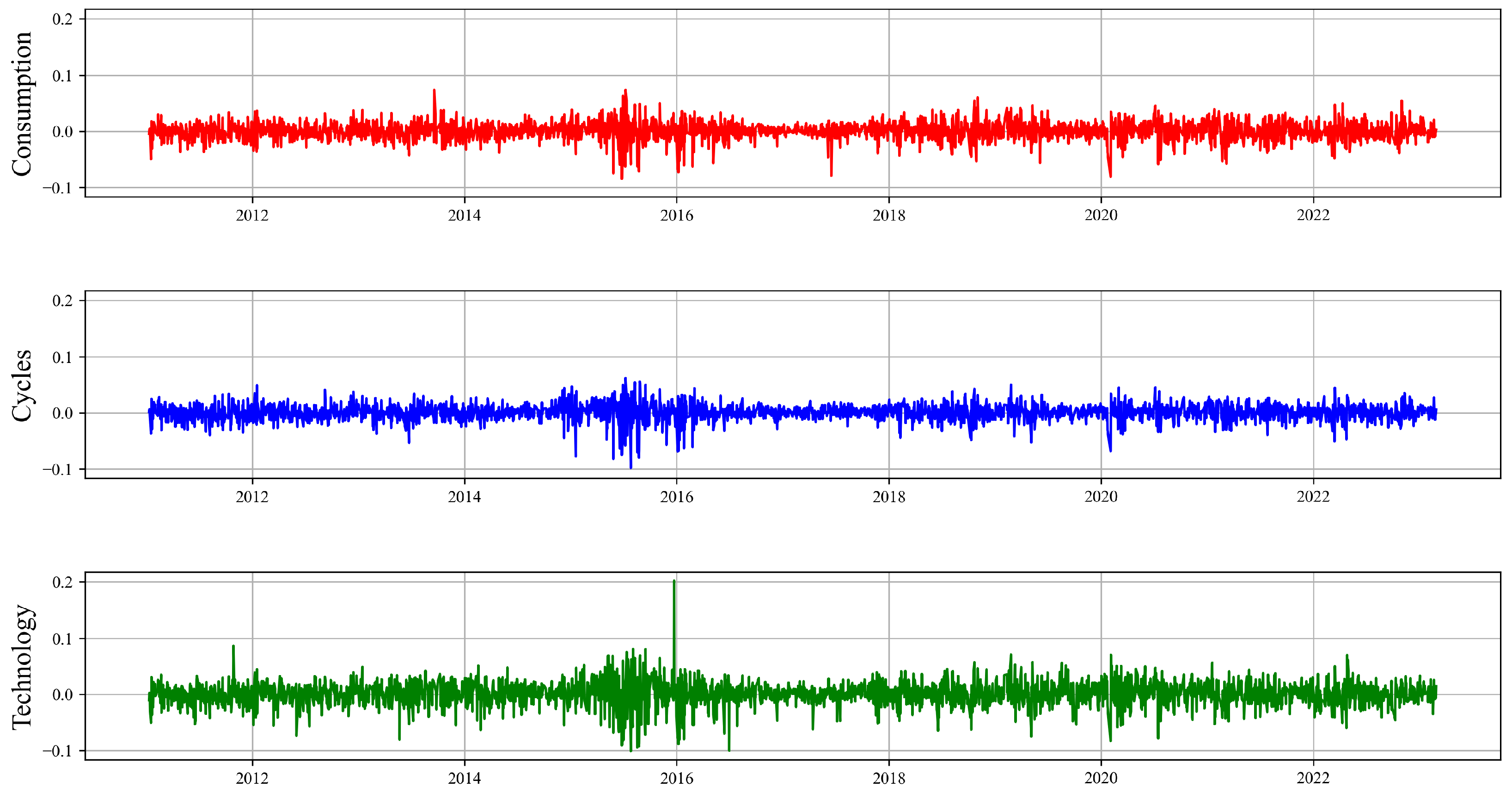
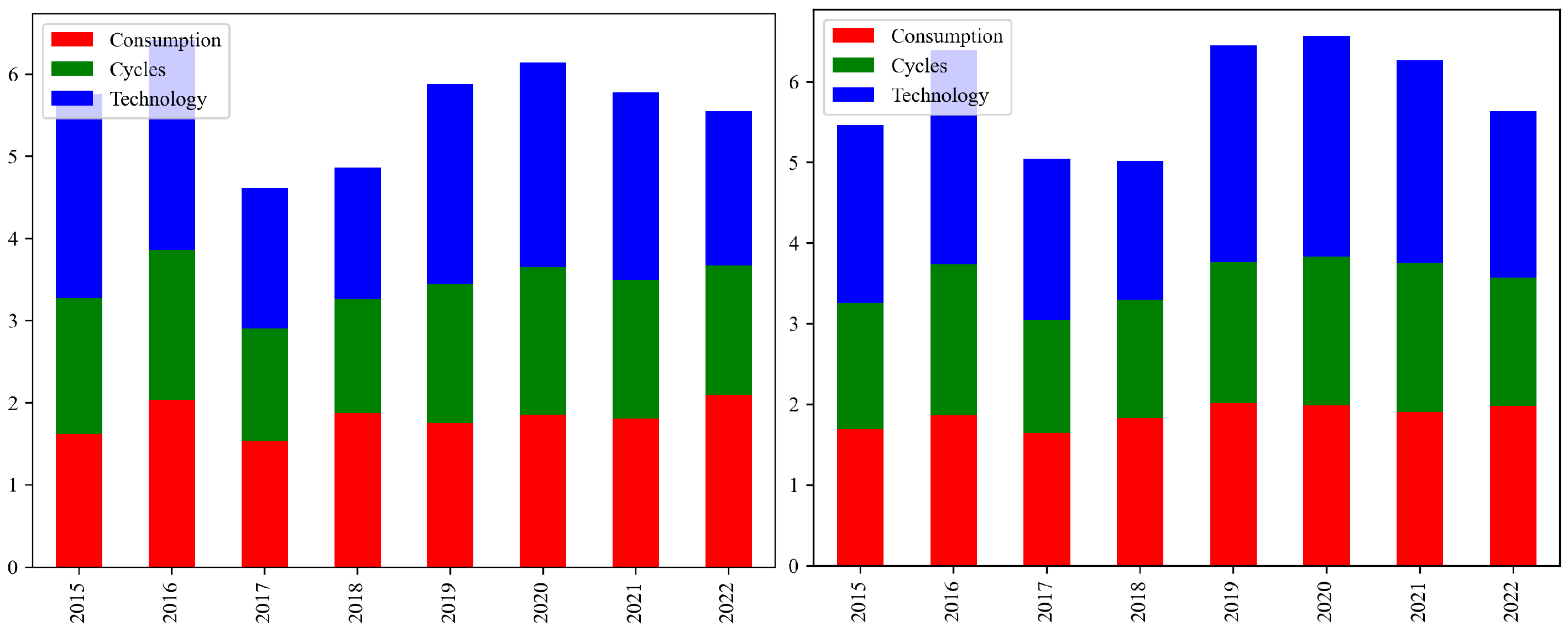
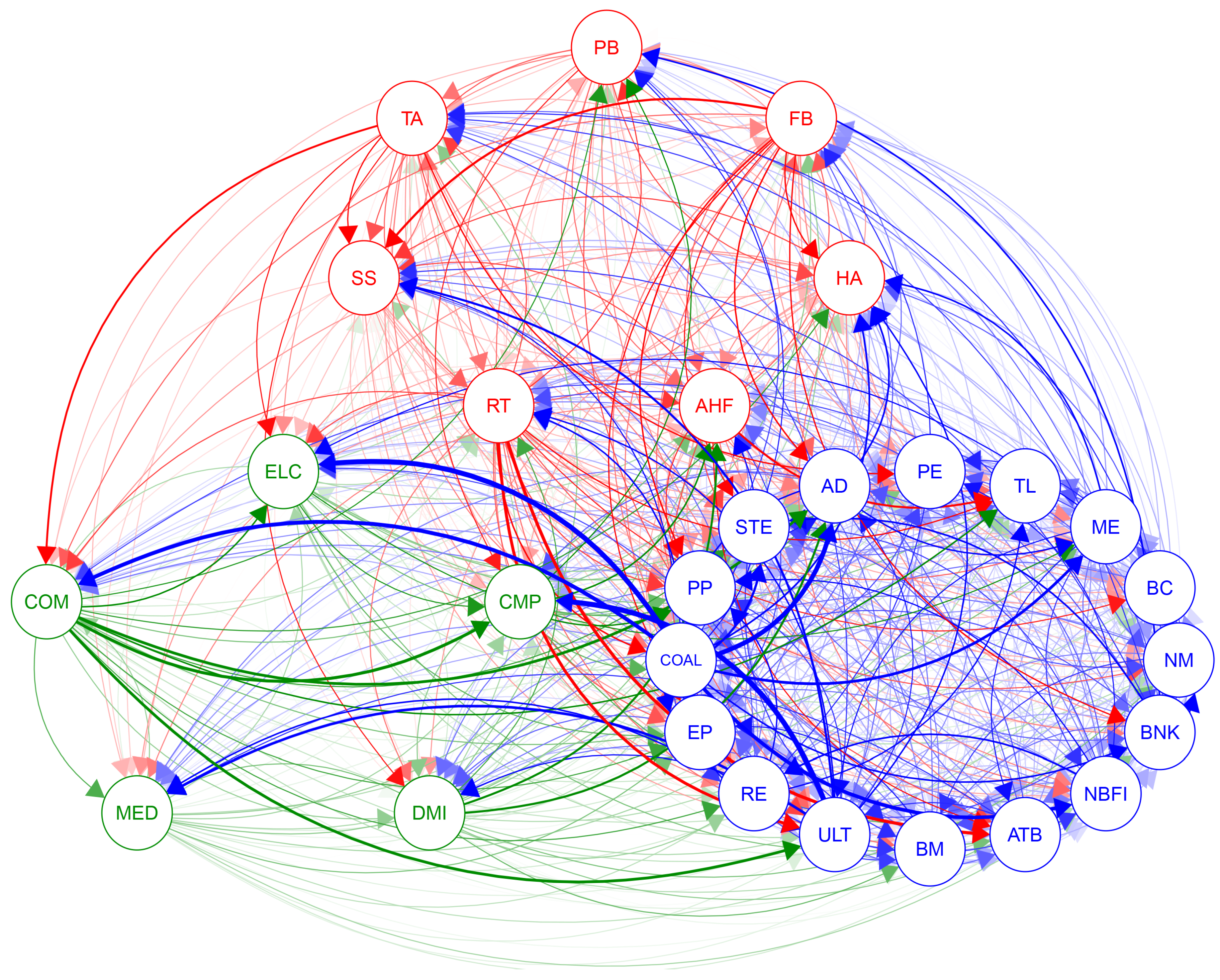

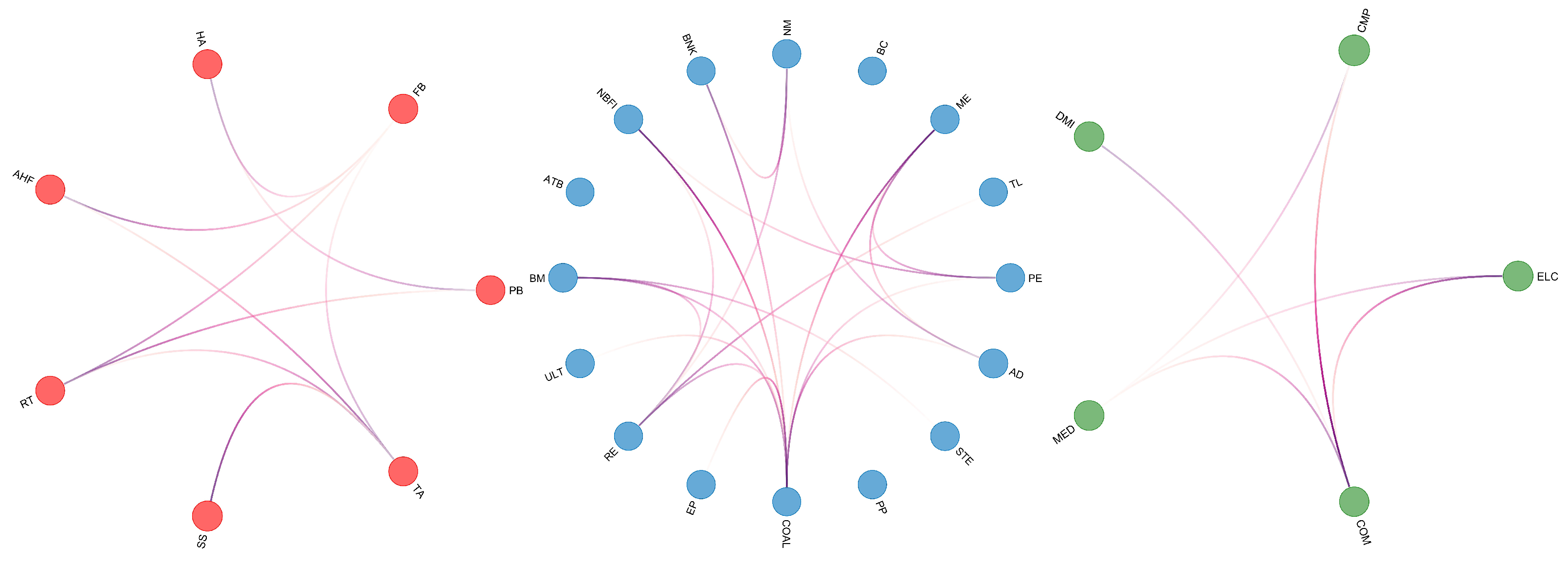




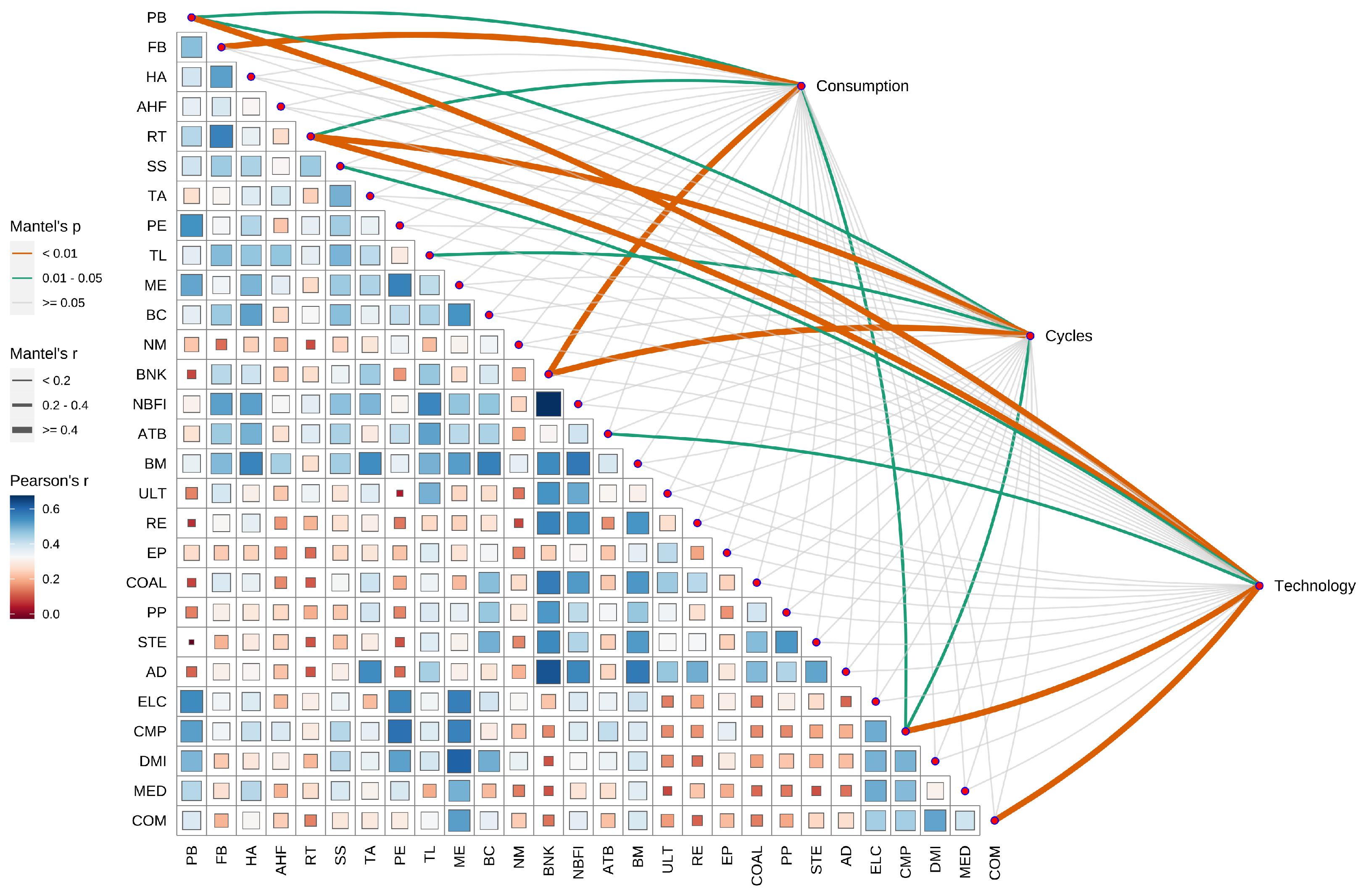
| Sector | Industry | Short Name | Stock Number |
|---|---|---|---|
| Consumption | Pharmaceuticals and Biotechnology | PB | 47 |
| Food and Beverage | FB | 14 | |
| Home Appliances | HA | 7 | |
| Animal husbandry and fishery | AHF | 5 | |
| Retail and Trade | RT | 2 | |
| Social Services | SS | 2 | |
| Textiles and Apparel | TA | 1 | |
| Cycles | Power Equipment | PE | 27 |
| Transportation and Logistics | TL | 17 | |
| Machinery Equipment | ME | 15 | |
| Basic Chemicals | BC | 13 | |
| Nonferrous Metals | NM | 11 | |
| Banking | BNK | 11 | |
| Non-banking Financial Institutions | NBFI | 11 | |
| Automobile | ATB | 11 | |
| Building Materials | BM | 10 | |
| Utilities | ULT | 9 | |
| Real Estate | RE | 7 | |
| Environmental Protection | EP | 6 | |
| Coal | COAL | 5 | |
| Petroleum and Petrochemical | PP | 5 | |
| Steel | STE | 5 | |
| Architectural Decoration | AD | 4 | |
| Technology | Electronics | ELC | 17 |
| Computers | CMP | 10 | |
| Defense and Military Industry | DMI | 10 | |
| Media | MED | 5 | |
| Communication | COM | 4 |
| Industry | Mean | Std | Skew | Kurtosis | JB | ADF | ESG Score |
|---|---|---|---|---|---|---|---|
| Consumption | |||||||
| PB | 0.010086 | 0.08859 | −0.13665 | 0.624106 | 633.64 *** | −15.01 *** | 7.54 |
| FB | 0.015326 | 0.087025 | −0.70071 | 1.733604 | 1797.25 *** | −42.47 *** | 7.40 |
| HA | 0.006595 | 0.096462 | −0.07841 | 2.431205 | 39,699.63 *** | −22.19 *** | 6.50 |
| AHF | 0.004386 | 0.099432 | 0.096996 | 0.842138 | 17,880.20 *** | −24.10 *** | 6.97 |
| RT | 0.020707 | 0.123142 | 0.574276 | 2.661631 | 173,612.12 *** | −18.97 *** | 8.46 |
| SS | 0.011169 | 0.107611 | −0.13489 | 2.627302 | 1772.35 *** | −55.93 *** | 7.17 |
| TA | 0.001209 | 0.095757 | −0.09315 | 4.630471 | 169,177.80 *** | −55.07 *** | 5.95 |
| Cycles | |||||||
| PE | 0.017288 | 0.11205 | 0.159149 | 0.624394 | 6589.24 *** | −54.89 *** | 7.98 |
| TL | 0.005048 | 0.088548 | 0.08035 | 2.066187 | 42,861.11 *** | −26.2 *** | 7.14 |
| ME | 0.003389 | 0.093523 | −0.42513 | 1.83023 | 3414.01 *** | −42.62 *** | 6.98 |
| BC | 0.012457 | 0.10663 | −0.28994 | 0.30381 | 33,553.87 *** | −21.66 *** | 7.99 |
| NM | 0.008695 | 0.144318 | 0.582843 | 4.77747 | 5153.30 *** | −55.56 *** | 7.47 |
| BNK | 0.003329 | 0.056745 | 0.780311 | 3.665301 | 6805.73 *** | −10.95 *** | 7.48 |
| NBFI | 0.005618 | 0.092892 | 0.022439 | 3.287873 | 37,753.71 *** | −9.45 *** | 6.94 |
| ATB | 0.009188 | 0.080367 | −0.12778 | 0.276506 | 19,123.80 *** | −13.35 *** | 7.25 |
| BM | 0.003713 | 0.095118 | −0.05981 | −0.03298 | 4999.93 *** | −40.43 *** | 7.47 |
| ULT | 0.007641 | 0.068062 | 1.004595 | 5.509093 | 55,050.59 *** | −11.69 *** | 7.11 |
| RE | 0.00782 | 0.100706 | 0.251563 | 1.69491 | 1269.81 *** | −41.57 *** | 6.17 |
| EP | 0.002075 | 0.099464 | −0.2805 | 0.747501 | 23,204.43 *** | −41.23 *** | 7.64 |
| COAL | 0.009856 | 0.082512 | 0.051158 | 0.3185 | 2046.22 *** | −57.39 *** | 6.68 |
| PP | 0.00498 | 0.081159 | 1.39561 | 4.322518 | 10,576.62 *** | −10.46 *** | 7.91 |
| STE | 0.007925 | 0.092402 | 0.408978 | 9.32103 | 44,160.83 *** | −41.55 *** | 7.45 |
| AD | 0.006064 | 0.104453 | 2.088332 | 9.514282 | 6635.51 *** | −10.28 *** | 7.63 |
| Technology | |||||||
| ELC | 0.013052 | 0.125885 | −0.08578 | 0.895578 | 1232.19 *** | −54.48 *** | 7.65 |
| CMP | 0.009701 | 0.116605 | 0.044559 | −0.12171 | 3907.88 *** | −17.41 *** | 7.76 |
| DMI | 0.011402 | 0.107171 | 0.46677 | 1.22349 | 1766.90 *** | −54.80 *** | 6.68 |
| MED | 0.017207 | 0.180063 | 1.141347 | 6.081793 | 6,117,181.22 *** | −14.34 *** | 7.84 |
| COM | 0.006243 | 0.113371 | 0.419617 | 2.474634 | 19,219.10 *** | −12.60 *** | 6.72 |
| Industry | VaR Mean | VaR Std | CoVaR Mean | CoVaR Std |
|---|---|---|---|---|
| Consumption | ||||
| PB | −0.1313 | 0.0686 | −0.1393 | 0.0371 |
| FB | −0.1166 | 0.0883 | −0.1191 | 0.0471 |
| HA | −0.1398 | 0.0917 | −0.1489 | 0.0568 |
| AHF | −0.1491 | 0.0797 | −0.1513 | 0.0456 |
| RT | −0.1575 | 0.0971 | −0.1766 | 0.0573 |
| SS | −0.1776 | 0.0876 | −0.1974 | 0.0619 |
| TA | −0.1859 | 0.0982 | −0.1891 | 0.0741 |
| Cycles | ||||
| PE | −0.1353 | 0.0774 | −0.1422 | 0.0507 |
| TL | −0.1382 | 0.0807 | −0.1552 | 0.0428 |
| ME | −0.1528 | 0.0893 | −0.1524 | 0.0679 |
| BC | −0.1696 | 0.0888 | −0.1777 | 0.0447 |
| NM | −0.2158 | 0.1144 | −0.2212 | 0.0633 |
| BNK | −0.0881 | 0.0352 | −0.0833 | 0.0222 |
| NBFI | −0.134 | 0.0958 | −0.1362 | 0.0692 |
| ATB | −0.1042 | 0.0633 | −0.1196 | 0.0297 |
| BM | −0.1448 | 0.0732 | −0.1458 | 0.0472 |
| ULT | −0.098 | 0.0616 | −0.0951 | 0.0393 |
| RE | −0.1515 | 0.0852 | −0.1556 | 0.0463 |
| EP | −0.1617 | 0.0791 | −0.1638 | 0.0409 |
| COAL | −0.1129 | 0.0533 | −0.1206 | 0.0345 |
| PP | −0.1041 | 0.0467 | −0.1153 | 0.032 |
| STE | −0.1206 | 0.0653 | −0.143 | 0.0362 |
| AD | −0.1312 | 0.0673 | −0.1374 | 0.0418 |
| Technology | ||||
| ELC | −0.157 | 0.1019 | −0.1853 | 0.0541 |
| CMP | −0.1616 | 0.0775 | −0.1803 | 0.0435 |
| DMI | −0.1562 | 0.0784 | −0.1624 | 0.0413 |
| MED | −0.2543 | 0.1524 | −0.2738 | 0.0733 |
| COM | −0.1731 | 0.1108 | −0.1834 | 0.0666 |
| Rank | Industry | Received Link from | Transmitted Link to | In-Degree |
|---|---|---|---|---|
| 1 | COAL | ME, CMP, BM | DMI, PE, TA | 31.369 |
| 2 | PE | AHF, TA, STE | COAL, RT, MED | 23.160 |
| 3 | DMI | RE, NM, MED | CMP, COAL, COM | 22.458 |
| 4 | COM | CMP, RE, TA | PE, FB, TA | 22.115 |
| 5 | RT | STE, BC, ATB | PE, DMI, BM | 21.948 |
| 6 | CMP | MED, NM, AHF | COM, PE, FB | 20.745 |
| 7 | BM | AHF, SS, TA | COAL, COM, PE | 18.842 |
| 8 | RE | AHF, NBFI, DMI | PE, DMI, BM | 18.581 |
| 9 | FB | COM, TA, AD | COAL, PE, RT | 18.454 |
| 10 | MED | ME, RT, BC | CMP, DMI, COAL | 18.157 |
| Rank | Industry | Received Link from | Transmitted Link to | Out-Degree |
|---|---|---|---|---|
| 1 | TA | COM, PE, COAL | COAL, PE, COM | 18.881 |
| 2 | AD | AD, COM, STE | COAL, DMI, CMP | 17.844 |
| 3 | RT | STE, BC, ATB | PE, DMI, BM | 17.130 |
| 4 | RE | AHF, NBFI, DMI | DMI, COAL, COM | 17.022 |
| 5 | AHF | STE, BC, ATB | PE, CMP, RT | 16.972 |
| 6 | COAL | ME, CMP, BM | DMI, PE, TA | 16.921 |
| 7 | CMP | MED, NM, AHF | COM, PE, FB | 16.608 |
| 8 | NM | ULT, ME, TA | DMI, CMP, MED | 16.273 |
| 9 | COM | CMP, RE, TA | PE, FB, TA | 16.120 |
| 10 | STE | TA, MED, CMP | RT, PE, MED | 15.859 |
| Time | First | Second | Third | Fourth | Fifth |
|---|---|---|---|---|---|
| 2015–2016 | BNK | STE | PP | ATB | ELC |
| 2016–2017 | FB | BM | NM | EP | ELC |
| 2017–2018 | FB | NM | ME | BNK | PB |
| 2018–2019 | ELC | MED | PB | BM | HA |
| 2019–2020 | DMI | RE | EP | BC | PE |
| 2020–2021 | TL | EP | PB | BNK | PP |
| 2021–2022 | PB | BNK | NBFI | MED | AD |
| 2022–2023 | BM | RT | ELC | ATB | COM |
Disclaimer/Publisher’s Note: The statements, opinions and data contained in all publications are solely those of the individual author(s) and contributor(s) and not of MDPI and/or the editor(s). MDPI and/or the editor(s) disclaim responsibility for any injury to people or property resulting from any ideas, methods, instructions or products referred to in the content. |
© 2024 by the authors. Licensee MDPI, Basel, Switzerland. This article is an open access article distributed under the terms and conditions of the Creative Commons Attribution (CC BY) license (https://creativecommons.org/licenses/by/4.0/).
Share and Cite
Hu, C.; Guo, R. Research on Risk Contagion in ESG Industries: An Information Entropy-Based Network Approach. Entropy 2024, 26, 206. https://doi.org/10.3390/e26030206
Hu C, Guo R. Research on Risk Contagion in ESG Industries: An Information Entropy-Based Network Approach. Entropy. 2024; 26(3):206. https://doi.org/10.3390/e26030206
Chicago/Turabian StyleHu, Chenglong, and Ranran Guo. 2024. "Research on Risk Contagion in ESG Industries: An Information Entropy-Based Network Approach" Entropy 26, no. 3: 206. https://doi.org/10.3390/e26030206
APA StyleHu, C., & Guo, R. (2024). Research on Risk Contagion in ESG Industries: An Information Entropy-Based Network Approach. Entropy, 26(3), 206. https://doi.org/10.3390/e26030206






